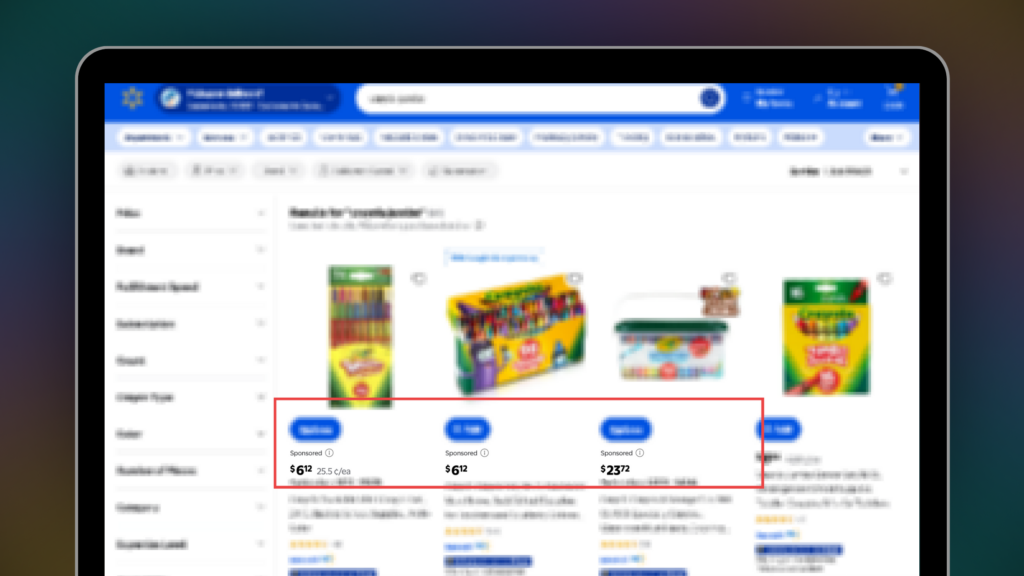- Blog
-
For Sellers
8 Walmart Marketplace seller challenges (+ How to overcome them)
From slow approvals to tough metrics, Walmart Marketplace isn’t easy. But these fixes can keep your growth on track.

Walmart Marketplace offers ecommerce sellers a massive opportunity to reach millions of customers. With no monthly subscription fees and access to Walmart’s enormous customer base, it’s an attractive platform for expanding your online business.
But let’s be real. Selling on Walmart comes with its own unique set of challenges. From a rigorous approval process to demanding performance standards, these obstacles can frustrate even experienced sellers.
This guide walks you through the most common Walmart Marketplace hurdles and provides practical solutions to overcome them. Let’s turn these challenges into opportunities for your business growth.
1. Navigating the approval process
Walmart carefully vets potential sellers before granting access to their marketplace. This selective approach helps maintain quality standards but also creates a significant barrier to entry.
Walmart looks for established sellers with a track record of success. You’ll need a U.S. business presence with a valid tax ID (EIN), compliant product listings, and reliable fulfillment capabilities. They also evaluate your business integrity and may conduct background checks on your selling history.
The application review typically takes 2-4 weeks, though delays are common if your documentation is incomplete or your products require additional vetting. Walmart doesn’t always send status updates, so regular checks of your Seller Center dashboard are essential.
Solution: Application preparation
Start by gathering all required documentation: your EIN, W-9 form, business address verification, and product catalog information. Check that none of your products appear on Walmart’s prohibited items list and ensure all your UPC/GTIN codes are correct and standardized.
Visit marketplace.walmart.com and click “Join Marketplace” to begin your application. Fill out the registration form with accurate business details and respond promptly to any additional verification requests from Walmart.
2. Fee structure and profitability
Walmart charges referral fees on each sale rather than a monthly subscription. These fees vary by product category and can significantly impact your margins if not properly accounted for.
Referral fees range from 5% to 15% based on your product’s category and price point. For example, apparel starts at 5% for items under $15 but jumps to 15% for items over $20. Electronics accessories are charged 15% for items up to $100 and 8% for anything over that threshold.
These fees apply to the total sales price, including the item cost, shipping, handling, and any gift wrap charges. Unlike Amazon, Walmart handles sales tax collection automatically for some states, removing that administrative burden from sellers.
However, for lower-priced items, these fees can still eat substantially into your profits. Additional costs further complicate the picture: returns processing, potential storage fees (if using Walmart Fulfillment Services), and classification errors can all affect your bottom line. International sellers must also account for currency conversion costs.
Solution: Pricing formula that accounts for fees
Use this simple formula to protect your profitability:
| Recommended Selling Price = (Item Cost + Handling + Shipping + WFS Fees + Fixed Expenses) ÷ (1 – Referral Fee % – Target Profit Margin) |
For example, if you have a $10 item with $3 in shipping and handling costs, a 15% referral fee, and you want a 20% profit margin, your calculation would be: $13 ÷ (1 – 0.15 – 0.20), then $13 ÷ 0.65 = $20.00
To further monitor your Walmart expenses and profitability in real-time, you can use a tool like FeedbackWhiz Profits. It makes it easier to track performance across your entire catalog and quickly identify any issues affecting your margins. And if you’re selling on Amazon too, you can view your numbers on both platforms so you can easily compare and make strategic decisions.
3. Visibility in Walmart search
Getting your products seen on Walmart requires understanding their unique search algorithm, which differs significantly from Amazon’s approach.
Walmart prioritizes offer competitiveness over pure content relevance. Price, shipping speed, and inventory status carry major weight in search rankings.
Your Order Defect Rate and customer response time directly impact visibility. Walmart recently implemented AI-powered search that understands contextual queries (like “football watch party”), delivering results based on use cases rather than just keyword matching.
This means that poor content structure in titles, descriptions, and attributes can lead to reduced indexing in search filters. Products misclassified in the wrong categories won’t appear in relevant search results. Low-quality images or missing rich media reduce conversion rates, which suppresses rankings. Sellers offering slow shipping or not participating in Walmart’s TwoDay/ThreeDay programs see significantly reduced organic placement in search results as well.
Solution: Walmart-specific SEO tactics
Structure your titles using Walmart’s preferred format: Brand + Style + Feature + Material + Size + Pack Count. Write detailed descriptions of 150+ words with 3-10 bullet points highlighting key features, focusing on relevant keywords without fluff.
Category accuracy is critical because misplacing an item prevents it from showing in filters. Fill out all relevant attributes to ensure visibility in sidebar filters, and study top-performing listings in your niche for guidance.
Upload at least four high-resolution images (minimum 1000×1000 pixels) on a white background (RGB 255,255,255). Include videos or 360° views when possible to boost engagement. And remember that competitive inventory, pricing, and shipping options are just as important as content for gaining visibility.
4. Marketplace competition
Walmart Marketplace hosts over 150,000 sellers and continues to grow rapidly. This competitive landscape requires strategic positioning to stand out.
Not to mention that sellers compete not only with each other but also with Walmart’s own retail inventory. Popular categories like electronics, beauty, and home goods are highly saturated with price-sensitive shoppers.
Walmart often undercuts third-party sellers in top categories with its own private labels or vendor-stocked items. These Walmart-owned listings receive preferential treatment in search results and featured placements. They benefit from prime shelf placement, inherent customer trust through badges and fulfillment speed indicators, and promotional pricing at scale that independent sellers can’t match.
Solution: Niche selection strategy
Focus on underserved micro-niches where Walmart has limited direct offerings. Examples include eco-friendly pet grooming kits or regional ethnic grocery products.
Use competitive research tools to identify low-competition, high-search areas. Target product lines that benefit from rich content and brand storytelling, where big-box players don’t compete effectively.
Also, consider creating bundles or variations (such as custom kits or multi-pack sizes) to differentiate your offerings from Walmart’s commodity products. This strategy helps you carve out your own space in the marketplace rather than competing head-on with Walmart’s retail operations.
5. Limited advertising options
Walmart’s advertising platform, Walmart Connect, offers fewer options than Amazon or eBay. This limitation requires more strategic ad spending to achieve meaningful results.
Here are some of the ad formats Walmart offers through its Walmart Connect platform:
- Sponsored Search Ads appear directly in search results when customers use relevant keywords.
- Onsite Display Ads show as banners across Walmart.com and their app during the customer journey.
- Brand Shop and Shelf options provide custom storefronts for eligible brands at no additional cost.
- Search Engine Marketing (SEM) lets Walmart manage Google Shopping Ads through its Self-Serve Marketing portal.
Solution: Maximizing results with the available options
Prioritize Sponsored Search Ads for the highest ROI. Test keywords carefully and optimize bids based on performance data. You should also use the Walmart Connect Academy to become certified and learn platform-specific optimization techniques.
If you’re eligible, create SEO-optimized Brand Shop pages to capture long-tail brand search traffic. Participate in Walmart’s SEM program if your catalog has strong search relevance, so Walmart can bid efficiently on Google Shopping.
Finally, track campaign performance using ROAS dashboards and quickly remove underperforming ads, especially during the “learning” phase when the algorithm is calibrating. This focused approach ensures your ad budget delivers maximum impact despite the platform’s limitations.
6. High performance standards
Walmart enforces strict seller performance metrics that directly impact your visibility and selling privileges. Understanding and meeting these standards is essential for long-term success.
Walmart evaluates sellers on a rolling 30-day basis using five core performance metrics.
- Your cancellation rate (percentage of orders canceled after confirmation) must stay below 2%.
- On-time delivery needs to exceed 90% of orders.
- Valid tracking rate measures the percentage of orders with valid tracking information uploaded and must exceed 99%.
- Refund rate (percentage of orders refunded for seller-caused issues) should remain below 6%.
- Seller response rate tracks customer inquiries answered within 48 hours and must exceed 95%.
Note: These metrics apply only to seller-fulfilled orders. Orders fulfilled through Walmart Fulfillment Services are exempt from these performance requirements.
Performance alarms trigger when critical metrics fall below thresholds.
- Auto-cancel alarms occur with late shipping and no tracking updates.
- Late origin scan flags appear when tracking is provided, but the carrier hasn’t scanned the package within 48 hours.
- Sales velocity alarms suppress listings due to sudden abnormal sales spikes, often from pricing errors.
- Cancellation velocity alarms remove listings after excessive order cancellations.
Penalties escalate through three tiers: suppression (seller-fulfilled listings are hidden), suspension (all listings, including WFS, are removed), and termination (permanent loss of selling privileges and Seller Center access).
Solution: Performance monitoring system
Create a real-time performance monitoring system to track daily metric snapshots, set alerts for threshold breaches, flag late shipments, and time customer responses. Walmart’s Performance Dashboard inside Seller Center is your primary tool, but it requires manual checking.
Fortunately, at least for tracking product reviews, FeedbackWhiz Alerts can help Walmart sellers. You can set it up so you’ll receive alerts for new positive or negative reviews.
You can then use this to track historical rating trends and correlate them with performance metrics to identify patterns. You can even integrate alerts with your internal communication systems like Slack to respond faster to feedback-driven issues and maintain your performance standards.
7. Seasonal fluctuation management
Walmart experiences significant traffic and conversion spikes during key shopping periods. Managing inventory through these fluctuations requires careful planning.
Major traffic surges occur during back-to-school (July-September), holiday season (November-December), tax refund season (February-April), and Walmart-specific events like Walmart Deals, Summer Savings, and Black Friday. High-velocity categories during these periods include toys, electronics, home goods, beauty, and apparel. Walmart heavily promotes these seasonal events both on their site and externally through Walmart Connect and Google Shopping ads.
Solution: Seasonal planning framework
Start with data-driven forecasting by reviewing 1-2 years of Walmart sales data per SKU. Factor in category-specific growth rates during seasonal cycles to predict demand accurately.
Then, implement inventory buffering by increasing stock 20-40% ahead of known events based on demand risk. Consider using Walmart Fulfillment Services to store overflow inventory and meet fast-shipping thresholds during peak periods.
Additionally, update seasonal imagery, titles, and keywords 30-45 days before key events. And run listing quality audits to improve shelf ranking before traffic spikes.
8. Customer service requirements
Walmart holds sellers to high customer service standards that directly impact your account health and selling privileges.
Sellers who fulfill their orders themselves are fully responsible for all customer care. This includes product inquiries, delivery status updates, returns processing, and refund management. Walmart expects professional communication with customers: courteous, solution-focused, and non-confrontational, even when the customer is at fault. Their customer care agents may escalate cases to sellers and expect prompt resolution.
You must offer clear return and refund processes, order tracking updates, resolution for post-purchase issues, assistance with in-store returns (if enabled), and take responsibility for lost or delayed packages. You must also respond to all customer messages within 48 hours, including weekends and holidays.
Failure to meet this standard impacts your Seller Response Rate, which must exceed 95%. Customer messages arrive via your Seller Center Inbox or direct customer care email (if configured). Automated responses don’t count as valid replies unless followed by a real response addressing the customer’s issue.
Solution: Support automation options
Walmart provides built-in tools to streamline communication. Create message templates in Seller Center (Account Settings > Message Templates) with predefined replies for common issues. Insert dynamic tags like Order ID and Customer Name for personalization.
Then, connect your customer support email accounts directly to Seller Center so all inbound messages appear in the Inbox tab. Set up email/SMS notifications to avoid missing time-sensitive messages.
Is Walmart Marketplace worth it?
Despite these challenges, Walmart Marketplace offers significant opportunities for the right sellers. With no monthly subscription fees and access to Walmart’s massive customer base, the platform can be highly profitable when approached strategically.
Plus, the approval process, while stringent, ensures a marketplace with less low-quality competition. Once established, sellers with strong operational systems can thrive by focusing on underserved niches and maintaining excellent performance metrics.
Ready to simplify your multi-marketplace selling experience? Try Seller 365 to get FeedbackWhiz Alerts and Profits, plus eight other essential seller apps in one subscription. Start your free trial today and transform your marketplace challenges into growth opportunities.





















